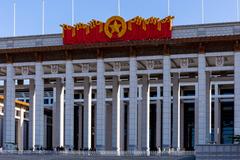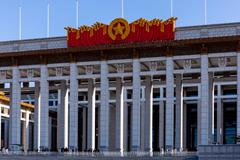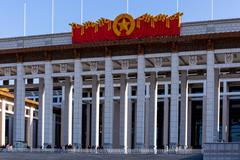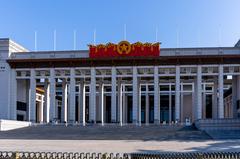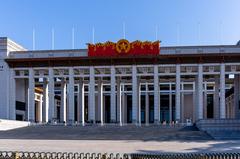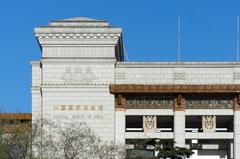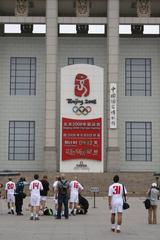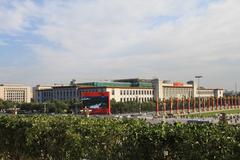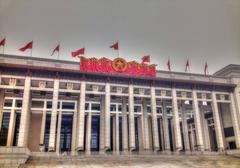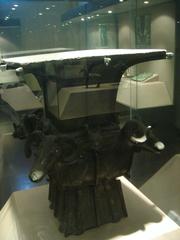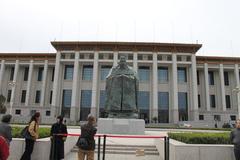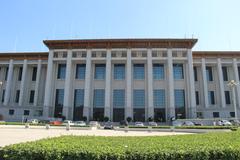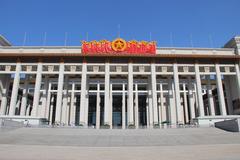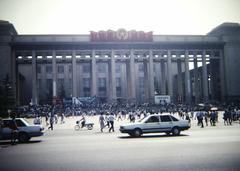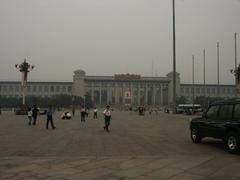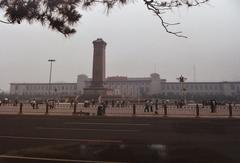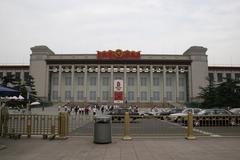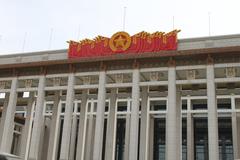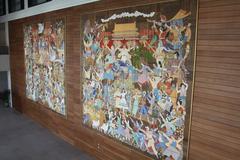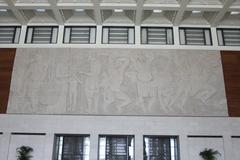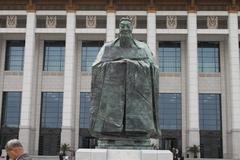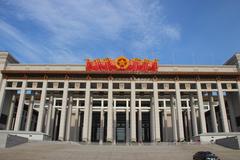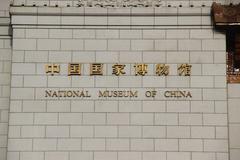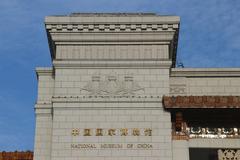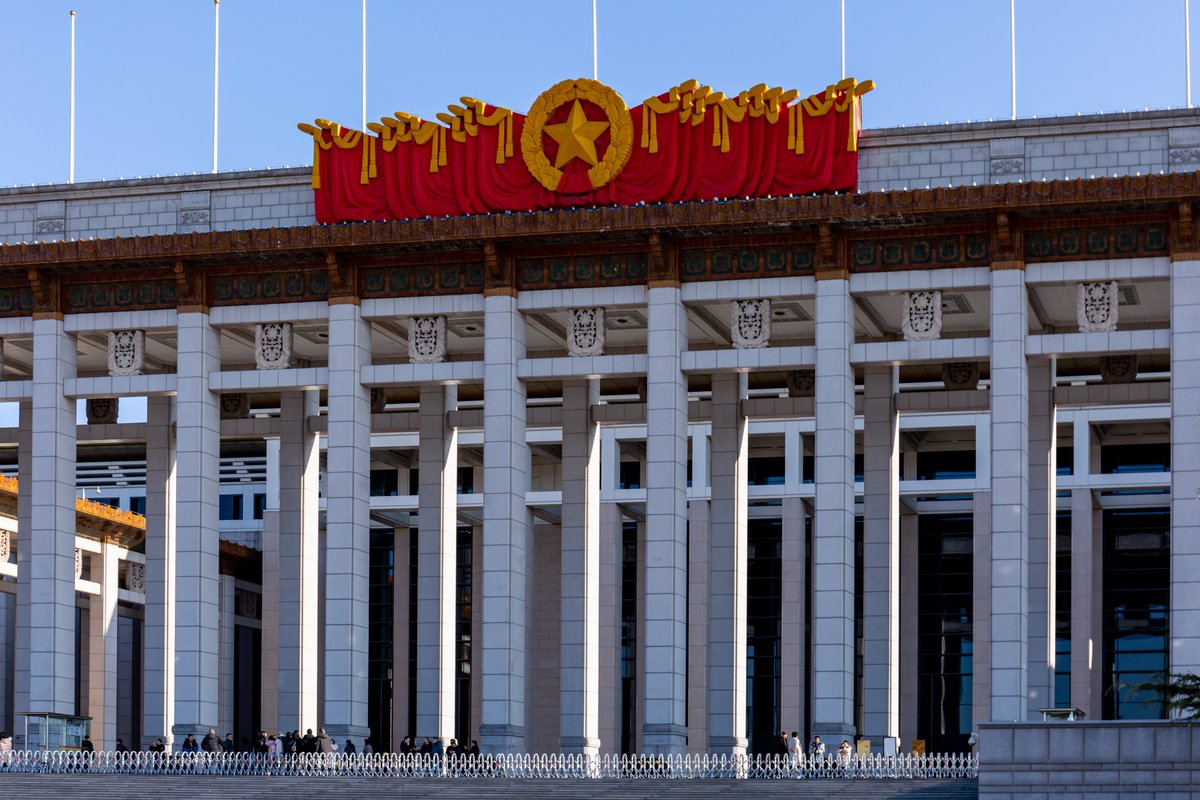
National Museum of China: Visiting Hours, Tickets, and Travel Guide to Beijing’s Historical Landmark
Date: 14/06/2025
Introduction
Prominently located on the eastern side of Tian’anmen Square, the National Museum of China (NMC) is a monumental institution that chronicles the profound tapestry of Chinese history and culture. Housing more than a million artifacts, the NMC offers visitors an immersive journey from prehistoric relics and imperial treasures to revolutionary memorabilia and contemporary achievements. As one of the largest museums in the world, its striking architecture and dynamic exhibitions make it a cornerstone for anyone exploring Beijing’s historical sites. This comprehensive guide will provide detailed insights into visiting hours, ticketing, accessibility, collections, travel tips, and nearby attractions—ensuring a rewarding visit to this iconic destination.
Table of Contents
- Historical Background and Development
- Architectural Evolution and Design
- Visiting Information
- Museum Collections and Highlights
- Permanent and Temporary Exhibitions
- Visitor Experience and Facilities
- Accessibility and International Visitors
- Nearby Attractions
- Frequently Asked Questions (FAQ)
- Practical Tips for a Memorable Visit
- Conclusion
- Further Resources
Historical Background and Development
Early Foundations
The roots of the NMC date back to July 1912, with the establishment of the Preparatory Office of the National Museum of History at Beijing’s Imperial College. By 1920, it became the National Museum of History and, in 1926, opened to the public, marking a milestone in cultural preservation (National Museum of China Official Website).
In 1950, the Central Revolution Museum was founded, focusing on modern revolutionary history. Both institutions eventually found a new home on Tian’anmen Square as part of the “Ten Great Constructions” commemorating the tenth anniversary of the People’s Republic of China in 1959 (chnmuseum.cn).
Mergers and Modernization
The two museums underwent several mergers and separations before formally uniting as the National Museum of China in 2003. A major renovation and expansion from 2007 to 2011 transformed the NMC into a modern, world-class facility with nearly 200,000 square meters of exhibition space (China Discovery).
Architectural Evolution and Design
Symbolic Location and Style
The NMC’s imposing structure is a blend of traditional Chinese and Soviet neoclassical architecture—signifying cultural continuity and political history. Its 260-meter façade, green copper roof with upturned eaves, and 40-meter central dome are visually connected to the nearby Forbidden City and Tian’anmen Square (ArchDaily; Britannica).
Renovation Highlights
The 21st-century expansion, led by German firm gmp Architekten, preserved the historic façade while adding spacious new wings and sustainable features such as natural lighting and energy-efficient systems. The interior’s vast central hall and symmetrical layout reflect traditional Chinese principles of harmony (ArchDaily; Designboom).
Visiting Information
Hours and Ticketing
- Open: Tuesday–Sunday, 9:00 AM – 5:00 PM (last entry at 4:00 PM)
- Closed: Mondays (except public holidays)
- Admission: Free, but advance online reservation is required (Chinatripedia)
- Booking: Official Ticket Reservation
Getting There
- Location: No. 16 East Chang’an Avenue, Dongcheng District, Beijing (east side of Tian’anmen Square)
- Subway: Line 1, Tian’anmen East or Tian’anmen West Station
- Bus: Numerous lines stop at Tian’anmen Square (TravelChinaGuide)
Museum Collections and Highlights
With over 1.4 million artifacts, the NMC’s collections span prehistoric jades, bronzes, ceramics, Buddhist sculptures, calligraphy, revolutionary relics, and more (China Discovery).
Notable Treasures
- Houmuwu Bronze Ding: The largest ancient bronze vessel ever discovered, from the Shang Dynasty
- Simuwu Ding and Four Sheep Square Zun: Masterpieces of ancient bronze casting
- Painted Pottery Basin with Human and Fish Patterns: A Neolithic era highlight
- Ancient Jade Artifacts, Imperial Ceramics, and Historical Currency Collections
Permanent and Temporary Exhibitions
Permanent Exhibitions
- Ancient China: From the Paleolithic era to the Qing Dynasty, featuring stone tools, bronzes, ceramics, and calligraphy
- The Road to Rejuvenation: Modern history from the Opium Wars to contemporary China
- Thematic Galleries: Focus on ancient food culture, costumes, currency, and more
Special Exhibitions
Regularly rotating special exhibitions cover topics from new archaeological finds to international art and science collaborations. Check the Exhibitions page for current schedules.
Visitor Experience and Facilities
Accessibility
The NMC is fully accessible, with barrier-free entrances, ramps, elevators, and accessible restrooms. Wheelchairs are available for loan, and tactile paving and Braille signage support visually impaired visitors (Ruqin Travel).
Services and Amenities
- Cloakroom: Free storage for coats, bags, and umbrellas
- Information Desks: Multilingual assistance, maps, and brochures
- Audio Guides: Available in multiple languages
- Guided Tours: Free tours in Chinese and English; advanced booking recommended
- Dining: Café and restaurant offering Chinese and Western options
- Museum Shop: Souvenirs, replicas, books, and educational materials
Security and Conduct
- Mandatory security screening at entry
- Large bags must be checked
- Photography allowed in most areas (no flash or tripods); check for restrictions in special exhibitions
- Eating, drinking, and loud noise are prohibited in galleries
Accessibility and International Visitors
- Foreign visitors: Bring passports for entry and ticket verification
- Currency: Bring RMB for purchases; major credit cards accepted in most areas
- Wi-Fi: Available in public spaces
Nearby Attractions
Located on Tian’anmen Square, the museum is within walking distance of other major attractions, including:
- Forbidden City
- Great Hall of the People
- Monument to the People’s Heroes
- Temple of Heaven (a short drive/bus ride away)
Combine your museum visit with a tour of these sites for a comprehensive experience of Beijing’s historical core.
Frequently Asked Questions (FAQ)
Q: Is admission to the National Museum of China free?
A: Yes; advance reservation is required.
Q: What are the visiting hours?
A: 9:00 AM – 5:00 PM, Tuesday–Sunday; closed Mondays except public holidays.
Q: Is the museum accessible to wheelchair users?
A: Yes, with barrier-free facilities and wheelchairs available for free loan.
Q: How do I get there by subway?
A: Take Line 1 to Tian’anmen East or Tian’anmen West Station.
Q: Are guided tours available?
A: Yes, in Chinese and English; audio guides are also available.
Q: Can I take photos inside?
A: Generally yes, except in certain galleries or special exhibitions; no flash or tripods.
Practical Tips for a Memorable Visit
- Reserve tickets online as early as possible, especially during holidays
- Arrive early to avoid crowds and secure your preferred entry time
- Wear comfortable shoes—the museum is vast
- Plan your itinerary to focus on key galleries and exhibitions
- Check the official website for exhibition updates and special event announcements
- Travel light; large bags must be checked at the cloakroom
Conclusion
The National Museum of China stands as a testament to the nation’s rich past and dynamic present. Its grand architecture, unparalleled collections, and comprehensive visitor services make it an essential destination for anyone interested in Chinese history and culture. By planning ahead and utilizing the museum’s resources, visitors can enjoy a meaningful, accessible, and enriching experience. For the latest updates, ticket bookings, and personalized itineraries, consult the official website and consider using travel apps like Audiala.
Further Resources
- National Museum of China Official Website
- China Discovery - Top Museums in Beijing
- Britannica: National Museum of China
- ArchDaily: National Museum of China by gmp Architekten
- Chinatripedia: National Museum of China Visitor Information
- TravelChinaGuide: Tickets & Booking
- Ruqin Travel: Beijing Wheelchair Accessible Travel Guide
